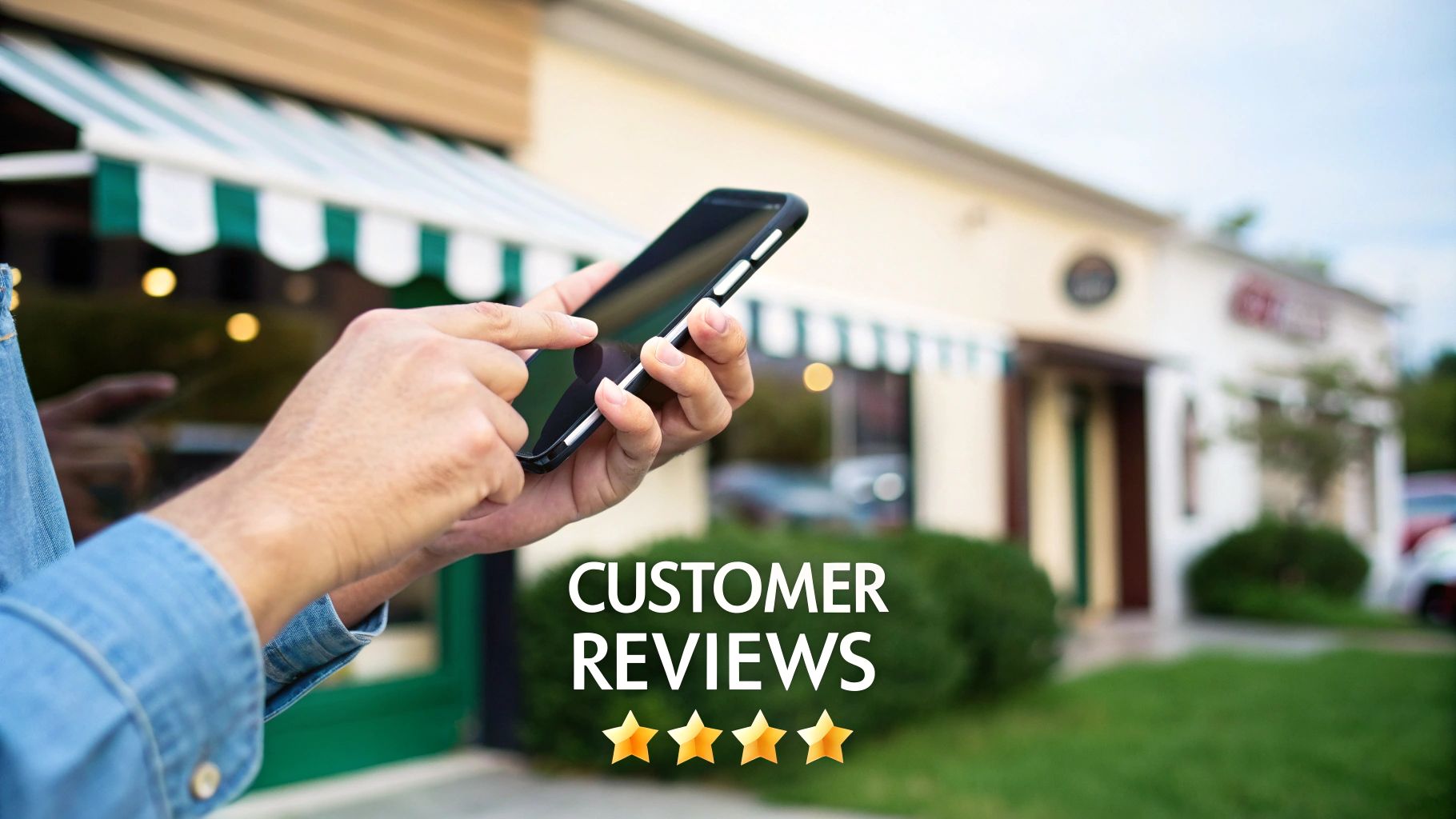In today’s crowded digital marketplace, simply having a website isn’t enough. For small businesses, standing out against larger competitors with bigger budgets can feel like an uphill battle. This is where a targeted Search Engine Optimisation (SEO) strategy becomes your most powerful tool. It’s not about spending a fortune; it’s about making clever, strategic moves that put your business in front of the right local customers at the exact moment they need you.
This guide cuts through the noise to deliver 10 practical, budget-friendly, and highly effective seo tips for small businesses. Forget abstract theories. We are diving into actionable steps you can implement today to improve your visibility, attract more qualified traffic, and turn searches into sales.
You will learn how to optimise your Google Business Profile for local searches, conduct keyword research that targets high-intent customers, and build a powerful online reputation through reviews and citations. We’ll also cover crucial technical elements like mobile optimisation, site speed, and structured data that search engines love. Whether you’re a local cafe, a specialised trade service, or a boutique online store, these strategies are designed to deliver measurable results and help your business thrive online.
1. Optimise Your Google Business Profile
Your Google Business Profile (GBP) is the cornerstone of local SEO and one of the most powerful free marketing tools available. This profile is the detailed business listing that appears in Google Maps and the “Local Pack” – the box of three local business results shown for searches like “cafe near me”. For small businesses targeting local customers, a fully optimised GBP is non-negotiable and a fundamental first step in any list of SEO tips for small businesses.
A well-managed profile builds trust and provides customers with immediate, crucial information, significantly boosting your visibility in local search results. For example, a local plumbing company can see a dramatic increase in calls simply by completing their profile, adding services, and actively collecting reviews.
How to Implement This Tip
To turn your profile into a customer-generating asset, focus on providing comprehensive and current information.
- Achieve 100% Completion: Fill out every single section Google offers. This includes services, attributes (like “wheelchair accessible”), business hours, and a detailed description.
- Use Specific Categories: Instead of just “Restaurant,” choose more precise categories like “Italian Restaurant” or “Vegan Cafe” to attract the right audience.
- Add High-Quality Photos: Consistently upload new photos of your premises, products, and team. Businesses with more than 100 photos often see better engagement.
- Leverage Google Posts: Use the “Posts” feature weekly to announce special offers, new products, or events. This keeps your profile looking active and fresh.
- Actively Manage Reviews: Respond to all reviews, both positive and negative, within 24-48 hours. This demonstrates excellent customer service and builds social proof.
- Enable Messaging: Allow customers to message you directly from your profile for quick questions, creating a low-friction communication channel.
2. Conduct Keyword Research Focused on Long-Tail Keywords
Instead of competing with large corporations for broad, high-volume keywords, one of the most effective SEO tips for small businesses is to target long-tail keywords. These are longer, more specific search phrases (usually three or more words) that indicate a user is further along in their buying journey. While they have lower search volume individually, they attract highly qualified traffic with greater conversion intent.

For example, a local pet groomer will struggle to rank for “dog grooming” but has a much better chance of capturing ready-to-book clients by targeting “mobile dog grooming for anxious dogs in Sydney”. This specificity reduces competition and speaks directly to a niche customer need, leading to more valuable website traffic. To effectively target your audience, a fundamental step is mastering how to choose keywords for SEO.
How to Implement This Tip
Integrating a long-tail keyword strategy involves understanding your customers’ specific problems and questions. This focus is a cornerstone of any successful local SEO campaign.
- Utilise Free Tools: Start with Google’s “People Also Ask” and “Related Searches” sections for ideas. Tools like AnswerThePublic can help you find questions people are asking related to your services.
- Focus on Purchase Intent: Prioritise phrases that include words like “buy,” “for sale,” “quote,” “near me,” or “best.” These signal a user is ready to make a decision.
- Think Locally: Combine your services with your location. An HVAC company should target “emergency furnace repair in Melbourne” rather than just “furnace repair.”
- Analyse Competitors: Use free versions of tools like SEMrush or Ahrefs to see what long-tail keywords your local competitors are ranking for and identify opportunities.
- Check Search Console: Use Google Search Console to find keywords you already rank for on pages 2-3 of search results. Optimising these pages can provide a quick boost.
3. Create Location-Specific Service Pages
For businesses serving multiple towns, suburbs, or regions, creating dedicated web pages for each location is a powerful local SEO tactic. These “hyperlocal” pages are designed to capture specific, high-intent searches like “electrician in Bondi” or “plumber near Chatswood.” By building out unique content for each service area, you signal to Google your direct relevance to customers in those specific locales, a crucial move in any list of SEO tips for small businesses.
This strategy goes far beyond simple keyword targeting; it establishes your business as an authority and a genuine local provider. For instance, a pest control company could create separate pages for different Sydney suburbs, each one detailing common local pests, specific council regulations, and testimonials from neighbourhood clients, dramatically increasing their chances of ranking in those areas.
How to Implement This Tip
To make your location pages effective, you must ensure each one offers unique value rather than just being a duplicated template.
- Write Unique, Substantial Content: Aim for at least 300-500 words of original content for each page. Discuss local landmarks, neighbourhood-specific challenges, or building styles relevant to your service.
- Include Local Social Proof: Add testimonials, case studies, or photos from customers in that specific area. This builds immense trust and authenticity.
- Embed a Local Map: Use an embedded Google Map that clearly outlines the service boundaries for that particular location.
- Feature Localised Details: Mention any relevant local regulations, council requirements, or community knowledge. For example, an electrician could mention specific heritage building codes in The Rocks.
- Add LocalBusiness Schema: Implement
LocalBusinessschema markup on each page, specifying the unique address or service area to give search engines precise, structured information. - Use a Clear Call-to-Action: Ensure each page has a prominent call-to-action (CTA) with a local phone number or a contact form to convert visitors into leads.
4. Optimize for Mobile-First Experience
In today’s digital landscape, your website’s mobile version is its primary identity. Mobile-first optimisation means designing for the smallest screen first, then adapting the experience for tablets and desktops. Google’s mobile-first indexing uses your site’s mobile version to rank its pages, making this approach a non-negotiable part of any modern SEO strategy for small businesses.

A seamless mobile experience directly impacts user engagement and conversions. For instance, a local retailer can slash their bounce rate by improving mobile page load speed, while a service-based business can see a 60% increase in calls simply by adding prominent click-to-call buttons. Prioritising mobile isn’t just a technical task; it’s a fundamental business decision that acknowledges how modern customers search and shop.
How to Implement This Tip
To ensure your website is a powerful tool on mobile devices, focus on speed, accessibility, and user-friendliness.
- Prioritise Page Speed: Aim for a load time of under three seconds on mobile devices. Use Google’s PageSpeed Insights tool to identify areas for improvement.
- Implement a Responsive Design: Your website should automatically adjust its layout to fit any screen size, providing an optimal viewing experience for every visitor.
- Simplify Navigation: Use clear, concise menus, often a “hamburger” icon, to help mobile users find what they need without overwhelming the small screen.
- Make Buttons Tappable: Ensure all buttons and links are large enough to be easily tapped with a thumb (at least 48×48 pixels) and have adequate spacing to prevent accidental clicks.
- Optimise Forms for Mobile: Keep contact and checkout forms short and simple. Enable autofill features to streamline the process for users.
- Ensure Text is Legible: Use a minimum font size of 16px for body text to ensure readability without requiring users to zoom in.
5. Build High-Quality Local Citations and NAP Consistency
Local citations are online mentions of your business’s core information: its Name, Address, and Phone number (NAP). These listings on directories, websites, and social platforms act as verification signals for search engines. Ensuring your NAP is absolutely consistent across the web is a major local SEO ranking factor that builds trust with both Google and potential customers.
This consistency reinforces the legitimacy and location of your business, making it a crucial element in any list of SEO tips for small businesses. For example, an HVAC company that built 50 consistent citations saw its local search rankings jump from page three to page one in just three months, demonstrating the powerful impact of this foundational tactic. It tells Google you are a legitimate, established local entity.
How to Implement This Tip
To leverage citations for better local rankings, focus on accuracy, relevance, and consistency across all platforms.
- Establish a Consistent NAP: Decide on one exact format for your name, address, and phone number and use it everywhere. For instance, always use “St.” or always use “Street” – don’t mix them.
- Start with Major Data Aggregators: Begin by ensuring your information is correct on foundational platforms like Google Business Profile, Apple Maps, Bing Places, and Facebook.
- Target Key General Directories: Get listed on high-authority general directories such as Yelp, Yellow Pages, and Foursquare.
- Find Industry-Specific Directories: Seek out niche directories relevant to your field, like Healthgrades for doctors or Avvo for lawyers, as these carry more weight.
- Perform a Citation Audit: Use a tool like Moz Local or BrightLocal to find existing citations, identify inconsistencies, and discover new listing opportunities.
- Claim and Update Listings: Search for your business online to find and claim any existing, unclaimed listings. Immediately update all citations if your business information ever changes. You can get help with this process from a local agency offering SEO services on the Sunshine Coast.
6. Generate and Manage Online Reviews Strategically
Online reviews are the modern-day word-of-mouth and a crucial ranking factor, especially for local SEO. Platforms like Google, Yelp, and industry-specific sites use review volume, velocity, and sentiment to judge your business’s authority and relevance. For small businesses, a proactive review strategy is one of the most effective SEO tips for small businesses as it directly influences both search rankings and customer purchasing decisions.
A steady stream of positive feedback builds immense trust and social proof. For instance, a local plumber who grew their Google reviews from just eight to over 100 in six months saw a 200% increase in call volume, securing a coveted spot in the local map pack. This demonstrates the direct link between reviews, visibility, and revenue.

How to Implement This Tip
To build a powerful review profile, integrate a systematic process into your daily operations.
- Prioritise Google Reviews: While other platforms matter, focus your primary efforts on Google as these reviews have the most significant impact on your local search ranking.
- Create a System: Don’t leave it to chance. Develop a consistent process to ask for reviews via email, SMS, or in-person after a successful service or purchase.
- Make It Easy: Provide customers with a direct link to your Google review page. This removes friction and significantly increases the likelihood of them leaving a review.
- Train Your Team: Empower your staff to request reviews at the point of service completion. A personal request from a satisfied customer is incredibly effective.
- Respond to Every Review: Engage with all feedback, positive and negative, within 24-48 hours. Thank positive reviewers and offer to resolve issues raised in negative comments.
- Showcase Reviews on Your Site: Use a widget or plugin to display your best reviews on your website, adding valuable social proof that can boost conversion rates.
7. Improve Website Loading Speed
Website loading speed is a critical ranking factor for Google and a cornerstone of user experience. In an era of instant gratification, a slow website doesn’t just frustrate visitors; it actively drives them away, increasing your bounce rate and tanking your conversion potential. Fast-loading sites are rewarded with better search engine visibility and higher customer retention, making this one of the most impactful SEO tips for small businesses.
A slow site directly harms your bottom line. For instance, an e-commerce store that cuts its load time from 8 to 2 seconds can see a dramatic drop in bounce rates and a significant increase in sales. Speed is essential for both desktop and mobile users, directly influencing everything from search rankings to how customers perceive your brand’s professionalism.
How to Implement This Tip
To boost your site’s performance, focus on optimising the technical elements that cause delays.
- Test and Benchmark: Use tools like Google PageSpeed Insights to get a baseline score. Your goal should be to achieve a score of 90 or higher.
- Optimise Images: Compress all images before uploading using tools like TinyPNG. Convert them to modern, fast-loading formats like WebP.
- Enable Browser Caching: This allows repeat visitors’ browsers to “remember” parts of your site, so it loads much faster on subsequent visits.
- Use a Caching Plugin: For WordPress sites, a caching plugin like WP Rocket can dramatically improve speed by creating static versions of your pages. You can read a full review of WP Rocket to see how it works.
- Minify Code: Reduce the file size of your HTML, CSS, and JavaScript files by removing unnecessary characters and spaces.
- Choose Quality Hosting: Avoid the cheapest shared hosting plans. Investing in a reliable, fast web host provides a solid foundation for a high-performing website.
8. Create Valuable, SEO-Optimised Content Regularly
Consistently producing high-quality content is a cornerstone of modern SEO, allowing your small business to build authority and attract qualified organic traffic. By creating articles, guides, or videos that answer your audience’s questions, you can rank for valuable long-tail keywords that your competitors might overlook. This strategy establishes your business as a trusted expert in its field. For example, an accounting firm that creates a detailed blog post about tax deductions for sole traders can attract highly relevant leads each financial year.
This approach transforms your website from a simple online brochure into a dynamic resource that continuously draws in new customers. It’s one of the most effective long-term SEO tips for small businesses because each piece of content acts as a digital asset, generating traffic and leads for years to come.
How to Implement This Tip
To make your content a powerful SEO engine, focus on quality, relevance, and consistency. To streamline your content planning and generation, exploring AI tools can be incredibly effective. Consider how you can leverage resources like these diverse ChatGPT prompts tailored for digital marketers to generate ideas and outlines.
- Target Specific Keywords: Dedicate each piece of content to one primary keyword and a few related secondary terms.
- Write for Humans First: Create content that is genuinely helpful, informative, and easy to read. Answer the questions your customers are actually asking.
- Optimise On-Page Elements: Include your target keyword naturally in the title, URL, H1 tag, and the first 100 words of your article.
- Use Structured Formatting: Organise your content with clear H2 and H3 subheadings, bullet points, and short paragraphs to improve readability.
- Build Internal Links: Link to other relevant service pages or blog posts on your own website to help search engines understand your site structure and keep users engaged.
- Refresh Old Content: Regularly update existing posts with new information, statistics, and images to keep them relevant and maintain their rankings.
9. Implement Schema Markup (Structured Data)
Schema markup, or structured data, is a powerful SEO tactic that acts as a translator between your website’s content and search engines. It’s a form of microdata that, once added to your website’s code, helps search engines understand your information more contextually. This allows them to serve rich, informative results known as “rich snippets” directly on the search results page, making your listing far more appealing to potential customers.
For a small business, this is a game-changer. Imagine a local bakery using schema to display star ratings, opening hours, and even the price of its famous sourdough directly in the search results. This enhanced visibility grabs attention, builds immediate trust, and significantly increases click-through rates without costing a cent in ad spend. It’s one of the more technical yet highly effective SEO tips for small businesses looking for a competitive edge.
How to Implement This Tip
Adding schema markup can sound complex, but there are tools to simplify the process. Focus on the most impactful types of schema for your business first.
- Start with LocalBusiness Schema: This is essential for any business with a physical location. It helps Google understand your address, opening hours, and contact details for local search results.
- Use Review/AggregateRating Schema: If you collect customer reviews, this markup allows you to display those valuable star ratings directly under your page title in search results.
- Implement FAQ Schema: Add this to service or product pages that answer common customer questions. This can help your page earn a larger, more prominent FAQ section in the search results.
- Leverage Product Schema: For e-commerce businesses, this is non-negotiable. It enables rich snippets for price, availability, and product ratings.
- Use Google’s Tools: Start with Google’s Structured Data Markup Helper to generate the code, and always validate your implementation with the Rich Results Test tool before it goes live.
10. Track Performance with Analytics and Reporting
You cannot improve what you do not measure. Tracking your SEO performance with analytics is not just for data scientists; it’s a crucial practice that turns guesswork into a clear, actionable strategy. It allows you to see which efforts are driving traffic, generating leads, and delivering a return on investment. This data-driven approach is one of the most vital SEO tips for small businesses, as it prevents wasted resources on ineffective tactics.
For instance, a local service business might discover through analytics that 70% of their new leads come from organic searches for a specific service. Armed with this knowledge, they can confidently invest more into creating content and optimising pages around that high-performing topic, directly boosting their bottom line. Without tracking, this valuable insight would remain hidden.
How to Implement This Tip
To start making informed decisions, focus on setting up a solid tracking foundation and monitoring the metrics that truly matter.
- Connect Key Tools: Set up Google Analytics 4 (GA4) and link it to your Google Search Console account. This gives you a complete picture of how users find and interact with your website.
- Define and Track Conversions: Identify your key business goals, such as form submissions, phone calls, or online bookings. Set these up as conversion events in GA4 to measure success accurately.
- Monitor Core SEO Metrics: Regularly review key performance indicators (KPIs) like organic traffic, keyword rankings for your target terms, click-through rates (CTR), and conversion rates from organic visitors.
- Analyse User Behaviour: Pay attention to which pages are most popular, how long users stay, and which content leads to conversions. This helps you understand what resonates with your audience.
- Create Simple Reports: Use Looker Studio (formerly Data Studio) to build a simple, visual dashboard that displays your most important metrics. A monthly review is a great starting point.
- Audit Your Tracking: Periodically check that your analytics tags are firing correctly to ensure the data you are collecting is accurate and reliable for decision-making.
Top 10 Small-Business SEO Strategies Comparison
| Item | 🔄 Implementation Complexity | ⚡ Resource Requirements | 📊 Expected Outcomes | 💡 Ideal Use Cases | ⭐ Key Advantages |
|---|---|---|---|---|---|
| Optimize Google Business Profile | 🔄 Low — 1–2 hrs setup; ongoing monitoring | ⚡ Minimal — free platform; time for photos & responses | 📊 High — local visibility boost (50–200%), more calls/visits | 💡 Single-location stores, walk-ins, service-area businesses | ⭐ Immediate local presence, review-driven trust, Maps integration |
| Conduct Keyword Research Focused on Long-Tail Keywords | 🔄 Medium — 4–8 hrs initial research; ongoing tweaks | ⚡ Low–Medium — free/low-cost tools; analyst time | 📊 Medium‑High — targeted organic traffic in 3–6 months | 💡 Small sites seeking fast rankings and high-intent users | ⭐ Higher conversion intent, lower competition, easier to rank |
| Create Location-Specific Service Pages | 🔄 Medium‑High — ~2–4 hrs per page; unique content needed | ⚡ Medium — content creation, local images, possible dev work | 📊 High — can increase local traffic 40–100% | 💡 Multi-location businesses and service-area targeting | ⭐ Highly relevant local rankings and improved user experience |
| Optimize for Mobile-First Experience | 🔄 High — redesign/testing across devices; iterative work | ⚡ Medium‑High — dev resources, testing tools, potential redesign cost | 📊 High — better rankings and conversions (20–80% uplift) | 💡 Businesses with majority mobile users (restaurants, retail) | ⭐ Superior UX, mobile indexing, higher conversion rates |
| Build High-Quality Local Citations and NAP Consistency | 🔄 Medium — 10–20 hrs initial audit & listing work | ⚡ Medium — manual effort or paid tools ($100–500/yr) | 📊 High — local rankings improvement (30–60%) over months | 💡 New or multi-location businesses needing consistent NAP | ⭐ Strong trust signals, broader directory visibility, backlinks |
| Generate and Manage Online Reviews Strategically | 🔄 Medium — process setup; ongoing weekly management | ⚡ Low–Medium — time for requests; optional automation tools | 📊 Very High — boosts rankings & conversions (25%+; can double conversions) | 💡 Reputation-dependent services (dentists, restaurants, plumbers) | ⭐ Social proof, CTR lift, direct impact on local pack rankings |
| Improve Website Loading Speed | 🔄 Medium‑High — 4–8 hrs for major optimizations; monitoring | ⚡ Medium — tools, CDN, hosting upgrades; possible developer cost | 📊 High — lower bounce, better rankings, higher conversions | 💡 E‑commerce and content-heavy sites with slow metrics | ⭐ Faster UX, improved Core Web Vitals, measurable conversion gains |
| Create Valuable, SEO-Optimized Content Regularly | 🔄 Medium — 3–6 hrs per post; ongoing publishing cadence | ⚡ Medium — writing resources or outsourcing ($50–300/article) | 📊 High (long-term) — compounding organic traffic and leads | 💡 Brands building authority and inbound lead pipelines | ⭐ Establishes authority, attracts backlinks, sustained organic growth |
| Implement Schema Markup (Structured Data) | 🔄 Low‑Medium — 1–4 hrs per page; requires validation | ⚡ Low — mostly free tools/plugins; minor developer time | 📊 Medium‑High — CTR lift (20–30%); richer SERP appearance | 💡 Sites needing rich snippets (local biz, e‑commerce, FAQs) | ⭐ Improves SERP real estate, supports voice search, higher CTR |
| Track Performance with Analytics and Reporting | 🔄 Medium — 2–8 hrs setup; ongoing reporting cadence | ⚡ Low–Medium — free tools available; analyst time for insights | 📊 High — data-driven prioritization and measurable ROI | 💡 Any business seeking measurable SEO/marketing results | ⭐ Enables informed decisions, detects issues, optimizes spend |
Your Next Steps to Sustainable SEO Success
Navigating the world of search engine optimisation can feel like a monumental task, but it doesn’t have to be. By breaking down the process into manageable, high-impact actions, you can build a powerful online presence that attracts the right customers. We’ve explored a range of practical seo tips for small businesses, from the foundational necessity of a fully optimised Google Business Profile to the technical finesse of implementing schema markup. Each strategy serves a distinct purpose, yet they all work together towards a single, powerful goal: increasing your visibility and driving sustainable growth.
The journey begins with understanding what your local customers are searching for. By mastering long-tail keyword research and creating location-specific service pages, you immediately position your business as the most relevant local solution. This hyper-local focus, combined with consistent NAP details across high-quality citations, builds a bedrock of trust with both users and search engines like Google.
From Foundation to Acceleration
Once your foundational elements are in place, the focus shifts to user experience and authority. A fast, mobile-friendly website isn’t just a technical requirement; it’s a critical factor in keeping visitors engaged. Similarly, strategically generating and managing online reviews and producing valuable, SEO-optimised content are not one-off tasks. They are ongoing processes that continuously build your brand’s reputation and demonstrate your expertise, signalling to Google that you are a credible authority in your field.
The most crucial takeaway is that SEO is a marathon, not a sprint. Consistency is the key to long-term success. Don’t feel pressured to implement all ten tips at once. Instead, choose one or two areas to focus on initially.
Your Action Plan:
- This Week: Conduct a thorough audit of your Google Business Profile. Is every section complete? Are your photos recent? Are you responding to all reviews?
- This Month: Start your long-tail keyword research. Identify five to ten phrases your ideal customer would use and plan a blog post or service page targeting one of them.
- This Quarter: Set up Google Analytics and Google Search Console. Begin tracking your performance to understand what’s working and where you can improve.
By committing to these incremental improvements, you transform SEO from an intimidating concept into a routine business activity. Each optimised page, positive review, and piece of content you create is an investment in your business’s future, building a digital asset that will generate leads and drive revenue for years to come. These seo tips for small businesses are designed to be your roadmap, guiding you toward a stronger, more visible online presence that helps you compete and thrive in the Australian market.
Feeling overwhelmed or ready to fast-track your results? The team at Digital Roo’s specialises in transforming these SEO strategies into measurable growth for local Australian businesses. Partner with us to build a powerful online presence that drives real-world success.

